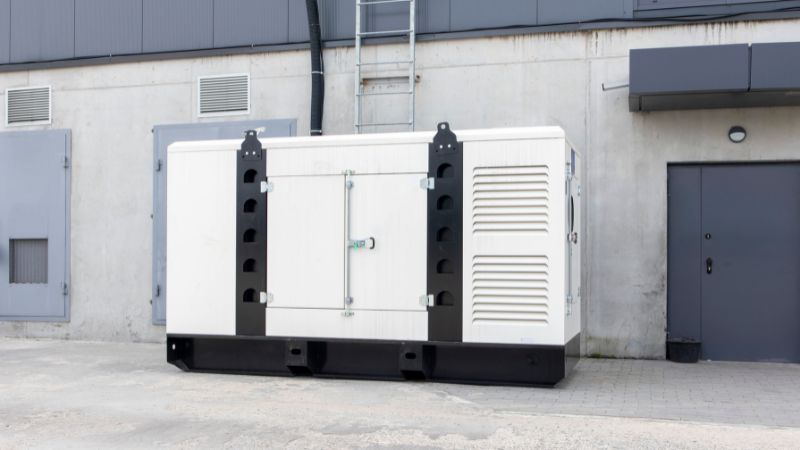
The revving and falling of a generator’s engine, accompanied by flickering lights and sputtering appliances, are all signs of a common and frustrating issue known as “surging.” This problem means your generator is delivering unstable power that can damage your appliances and electronics.
But don’t worry. In most cases, you can identify and fix the cause of a surging generator with some basic troubleshooting. This guide will walk you through the most common causes, from simple fuel issues to more complex mechanical problems, and help you determine when to tackle the job yourself and when it’s time to call in a professional.
What Exactly Is Generator Surging?

When a generator is “surging,” its engine is not running at a consistent speed. You’ll hear the RPMs (revolutions per minute) rise and fall, a sound often described as “hunting” . This fluctuation in engine speed directly causes a variation in the electrical output . Instead of a steady stream of power, your generator produces waves of electricity, leading to the flickering lights and groaning appliances that signal a problem.
Think of it like trying to drive a car with a sputtering engine; the ride is jerky and unreliable. Similarly, a surging generator provides a “jerky” and unstable supply of power. Addressing this issue promptly is crucial to protect your equipment and ensure your generator is ready to perform when you need it.
The Top Reasons Your Generator Is Surging
The good news is that the reasons for generator surging are often straightforward and can be resolved with a bit of maintenance. Let’s break down the most common causes, starting with the number one offender: the fuel system.
1. Fuel System Troubles: The Primary Suspect
More often than not, a surging generator is a thirsty or picky generator. The fuel system is the heart of your generator’s engine, and any disruption in the fuel supply can cause it to run erratically.
- Low or Incorrect Fuel: This might seem obvious, but it’s always the first thing to check. Running low on fuel can cause the engine to sputter and surge as it struggles to draw the last drops from the tank . Using the wrong type of fuel can also lead to poor performance and potential engine damage. Always consult your owner’s manual for the recommended fuel type.
- Old or Contaminated Fuel: Fuel doesn’t last forever. Gasoline can begin to degrade in as little as 30 days, forming gummy deposits and varnish that can clog up the entire fuel system . Water contamination, often from condensation, can also cause major problems. If your generator has been sitting for a while, stale fuel is a very likely cause of surging. It’s essential to use fresh fuel and to add a fuel stabilizer if you plan on storing your generator for more than a month .
- Clogged Carburetor: The carburetor is responsible for mixing air and fuel into the perfect ratio for combustion. Because of the small passages inside it, it is extremely sensitive to the gummy deposits left behind by old fuel. A clogged carburetor is one of the most frequent causes of generator surging . When the main jet or other passages are blocked, the engine is starved of fuel, causing it to “hunt” for a steady RPM.
- Dirty Fuel Filter and Lines: The fuel filter is designed to catch debris before it reaches the carburetor. Over time, this filter can become clogged, restricting fuel flow. Similarly, the fuel lines themselves can become blocked. If the engine isn’t getting a consistent supply of fuel, it can’t run smoothly, leading to surging.
- Propane Generator Issues: For those with propane-powered generators, a faulty regulator or a leak in a hose can disrupt the fuel delivery, throwing the fuel-air mixture out of balance and causing the generator to surge unpredictably.
2. Air System Problems
Just as an engine needs fuel, it also needs a steady supply of clean air.
- Clogged Air Filter: The air filter prevents dust, dirt, and debris from entering the engine. Over time, it will inevitably get dirty. A clogged air filter restricts airflow, which messes up the delicate air-fuel mixture the carburetor is trying to create . This “rich” mixture (too much fuel, not enough air) can cause the engine to run rough and surge.
3. Ignition System Faults
The ignition system creates the spark that ignites the fuel-air mixture. If that spark is weak or inconsistent, so is your engine’s performance.
- Dirty or Faulty Spark Plugs: Spark plugs are tough components, but they don’t last forever. They can become coated with carbon deposits or oil, which weakens the spark. A worn or “fouled” spark plug can cause misfires, which feel like a hiccup or a surge in the engine.
4. Load-Related Issues
Sometimes, the problem isn’t with the generator itself but with what you’re asking it to do.
- Overloading the Generator: Every generator has a maximum power output. If you connect appliances that draw more power than the generator can provide, the engine will struggle to keep up, causing it to surge and potentially shut down.
- Unbalanced Load: Even if you aren’t exceeding the total capacity, an imbalanced load can cause issues. Generators often have multiple outlets or circuits. If you plug all your high-power items into one side, it can cause the generator to run unevenly and surge.
5. Mechanical and Electrical Component Failure
If you’ve checked all the above and the problem persists, it may be time to look at some of the generator’s internal components.
- Governor Problems: The governor is a mechanical or electronic device that acts like cruise control for your generator. Its job is to maintain a constant engine speed, no matter how the electrical load changes. If the governor is malfunctioning or needs adjustment, it can cause the engine to “hunt” for the right speed, speeding up and slowing down repeatedly.
- Faulty Automatic Voltage Regulator (AVR): The AVR is responsible for maintaining a consistent voltage output. If the AVR fails, it can send confusing signals to the engine’s control system, leading to fluctuating voltage and engine surging . This is a serious issue that can quickly damage connected electronics.
- Other Mechanical Issues: Less common causes can include things like misaligned valves that need adjustment, low oil levels that prevent proper lubrication, or even loose bolts that cause excessive vibration.
How to Troubleshoot Your Surging Generator
Ready to do some detective work? Follow these steps to diagnose and hopefully fix your surging generator. Always prioritize safety: make sure the generator is turned off and cool before you begin.
Start with the Simple Stuff: Fuel and Air
- Check the Fuel Level: Is there enough fuel in the tank? Is it the correct type?
- Assess the Fuel Quality: If the fuel has been sitting for months, it’s probably the culprit. Safely drain the old fuel and replace it with a fresh supply.
- Inspect the Air Filter: Remove the air filter cover and take a look. Is it caked with dirt? If it’s a paper filter, replace it. If it’s a foam filter, you can often wash it with soap and water, let it dry completely, and then re-oil it (check your manual).
Examine the Spark Plug
- Carefully disconnect the spark plug wire. Use a spark plug socket to remove the plug.
- Look at the tip. If it’s black and sooty, oily, or has white deposits, it needs to be cleaned or replaced. Spark plugs are inexpensive, so replacing it is often the best bet.
Investigate the Carburetor
- This is a slightly more advanced step. Sometimes, you can resolve a minor clog without removing the carburetor. With the engine running, you can try partially applying the choke. If the engine smooths out, it’s a strong sign that the carburetor is clogged and not letting enough fuel through.
- For a more thorough fix, you may need to remove and clean the carburetor. This involves carefully disassembling it and cleaning the small jets and passages with a dedicated carburetor cleaner. If you’re not comfortable with this, it’s a good job for a professional.
Check Your Load
- Disconnect everything from the generator and start it up. Does it run smoothly without a load? If so, the issue might be with the appliances you’re connecting.
- Try plugging in items one by one, starting with a low-power item like a light bulb. Listen to the engine as you add each device. If it starts surging after you plug in a specific appliance, that device may be drawing too much power. Try to balance the load across the different outlets.
Preventive Maintenance
The secret to a reliable generator is regular care. By performing routine maintenance, you can prevent most surging issues from ever happening.

- Run Your Generator Regularly: Start your generator and let it run for 15-20 minutes every month. This keeps the engine lubricated and burns off moisture.
- Use a Fuel Stabilizer: If you don’t use your generator often, always add a quality fuel stabilizer to the tank. This will keep the fuel fresh for up to two years and prevent the carburetor-clogging deposits from forming .
- Follow the Maintenance Schedule: Your owner’s manual will have a recommended schedule for changing the oil, replacing the spark plug, and inspecting the air filter. Stick to it!
- Store It Properly: Keep your generator in a clean, dry location, protected from dust and moisture, to prevent corrosion and other issues.
When to Call a Professional
While many causes of surging are DIY-friendly, some problems require an expert touch. It’s time to call a qualified generator technician if:
- You’ve tried all the troubleshooting steps above, and the generator still surges.
- You suspect a problem with the governor or the Automatic Voltage Regulator (AVR). These components are complex and require special tools and knowledge to diagnose and repair.
- You’re simply not comfortable performing the necessary repairs yourself.
There’s no shame in calling for help; it’s safer than causing further damage to your generator or injuring yourself.
FAQs
My generator only surges when I’m running a specific appliance, like my refrigerator. What’s wrong?
This is a classic sign of an overload or an unbalanced load. The refrigerator’s compressor requires a large burst of power (called the “starting wattage”) to turn on. If this demand is too close to your generator’s maximum capacity, it can cause the engine to struggle and surge. Try unplugging other devices to see if the surging stops, or consider using a generator with a higher rated wattage for appliances with large motors.
What’s the difference between a surging and a generator that just won’t start?
They are different symptoms pointing to different problems. A generator that won’t start at all typically has a complete failure in one system—like no spark, no fuel, or a mechanical seizure. Surging, on the other hand, indicates a partial failure or blockage, often in the fuel delivery system, where the engine is getting just enough to run but not enough to run smoothly.
Conclusion
A surging generator can be a major headache, but it’s usually a problem with a clear solution. By understanding the common causes—primarily related to fuel, air, and load—you can work through the issue systematically.
Regular maintenance, especially careful fuel management, is your best defense against surging and will ensure your generator provides smooth, reliable power when you need it most. So, the next time your generator starts to “hunt,” don’t panic. Start with the basics, and you’ll likely have it running smoothly again in no time.
